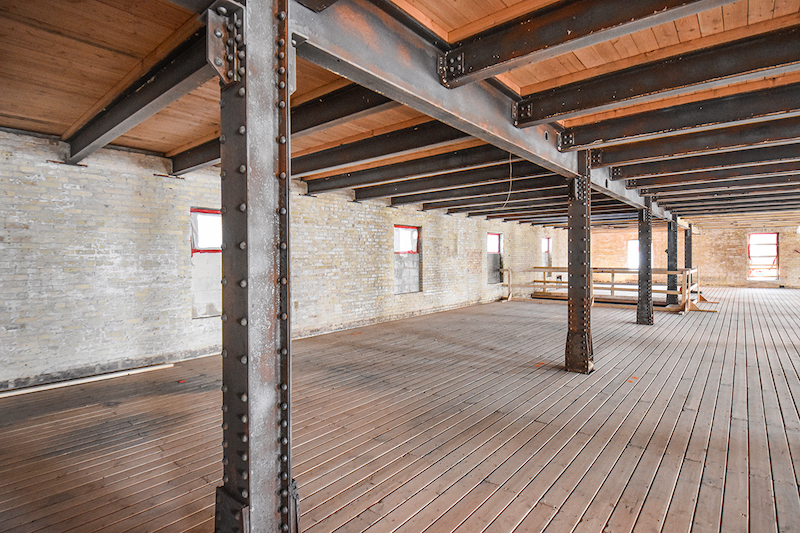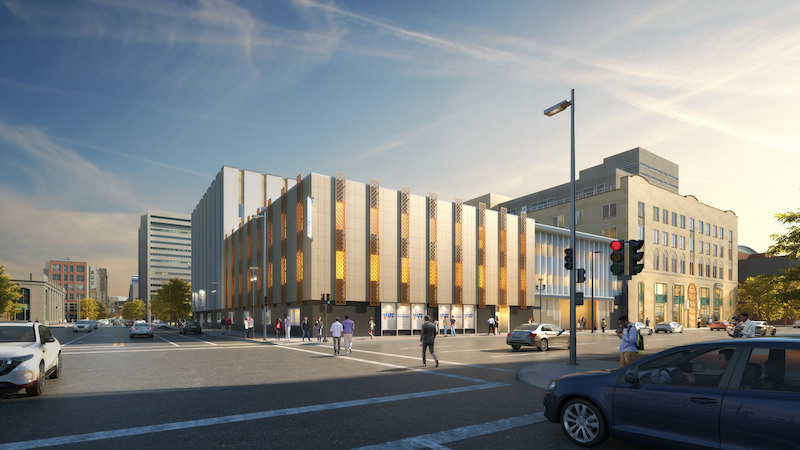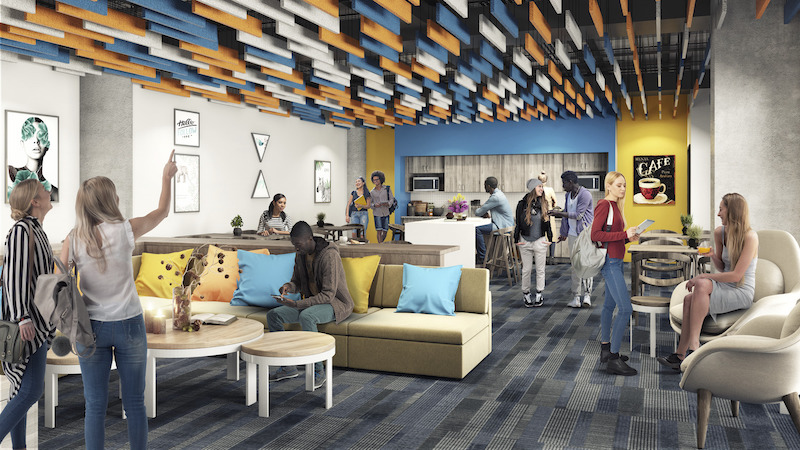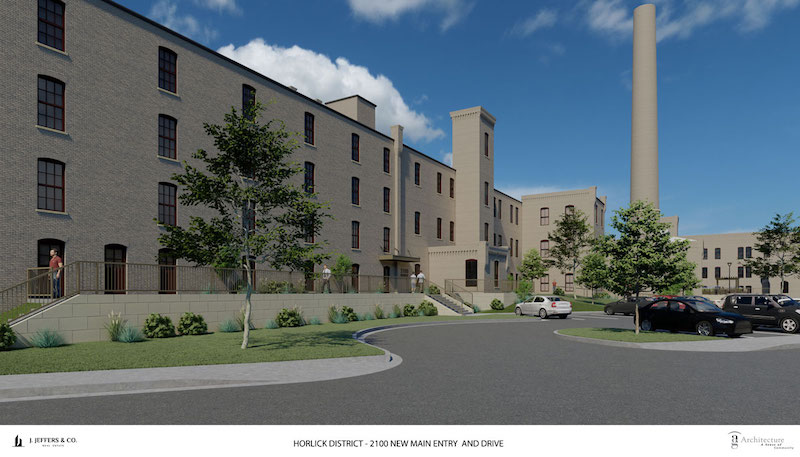Building Teams that include developer J Jeffers & Company and the general contractor CG Schmidt have three adaptive reuse projects underway in Wisconsin that attest to the unique challenges this kind of work presents, especially when historic preservation is a factor.
Scheduled for completion in July is the $40 million Phase 1 reconstruction of the Horlick Malted Milk factory complex in Racine dating back to 1875. This project’s Building Team—which also includes AG Architecture, JSD Engineering, and the historical consultant Heritage Consulting—is converting the northern building for 76 market-rate housing units. That building is being rebranded as Headquarters at Horlick. The southern building, renamed Horlick Flats, will have a mix of 60 market-rate and affordable apartments, managed in partnership with Lutheran Social Services.
Phase 1 will build out the infrastructure of this 13-acre complex, on which J Jeffers owns nine of 14 buildings and has contracts on the rest.
In Milwaukee, J Jeffers and CG Schmidt are working with Eppstein Uhen Architects and structural engineer Spire Engineering to adapt two buildings once home to the Milwaukee Journal Sentinel newspaper. (J Jeffers acquired the downtown block where the Journal Communications buildings sit for an undisclosed price in 2019.)
One conversion is a $27 million reconstruction, scheduled for completion in August, that is reimaging a 115,000-sf building originally completed in 1962 for student housing for Milwaukee Area Technical College (MATC). About one-third of the college’s 30,000 students had incomes last year low enough to qualify for financial aid, and the converted building will set aside 27 studio apartments for students earning less than 60% of the area’s median average. The building will also have two- and four-bedroom units, totaling 217 beds.
The other former Journal building under reconstruction, 256,000 sf and originally completed in 1924, will house 103 apartments. The first floor will contain the main lobby and amenity areas. The building’s original multi-story press room will be converted into an 8,800-sf restaurant and brew pub, and underground parking will be in the lower half of the former press room. The residential mix will consist of studio, one-, two-, and three-bedroom apartments as well as street-accessed walk-ups. This $55.7 million project is scheduled for completion in June 2022.
HISTORY PRESERVED, WHERE POSSIBLE

Horlick's tongue-and-groove floors and steel girds are being preserved in this building's reconstruction. Image: J Jeffers & Company
J Jeffers is defraying $100 million of the total cost of these three projects with assistance from federal and state historic tax credits.
Each project has its own set of design and construction criteria. The Horlick factory complex, which is on the National Register of Historical Places, had been abandoned for 45 years, and was so dilapidated the contractors couldn’t even do walkthroughs. While the Building Team razed and removed much of its nonhistorical components, Horlick’s thick exterior masonry walls and structural steel remain. Other architectural elements, such as restored Cream City brick, exposed tongue-and-groove wood flooring, ornate original support columns and steel girders incorporating old school hand-pounded rivets, are being preserved whenever possible.
BRINGING LIGHT TO DARK FLOOR SPACES

A former Milwaukee Journal-Sentinal building is being converted to student housing for Milwaukee Area Technical College. It will share underground parking with an adjacent Journal-Sentinal buiding that is being converted to residential apartments. Images: Courtesy CG Schmidt
 The adaptive reuses in Milwaukee are different stories. Each has floor plates that range from 30,000 to 35,000 sf, which meant that much of the interior space within the buildings had no access to natural light, which is essential to modern residential design. But preservation requirements also protected the buildings’ historic façade.
The adaptive reuses in Milwaukee are different stories. Each has floor plates that range from 30,000 to 35,000 sf, which meant that much of the interior space within the buildings had no access to natural light, which is essential to modern residential design. But preservation requirements also protected the buildings’ historic façade.
To bring light into these spaces, the Building Team created light wells lined with windows in the center of the buildings rather than expanding existing windows or creating new ones.
Each of the Journal buildings includes multi-story, open volume press rooms where newspapers had been printed. Since these rooms are considered part of the buildings’ historic significance, they must be generally preserved while also being repurposed for modern use. Over 160 parking spaces totaling 90,000 sf will be provided in the lower levels of the two adjoining buildings. To achieve this, CG Schmidt and Spire Engineering had to negotiate limited 14-ft clearance within that space to use heavy equipment. Underground concrete parking decks and the new parking garage ramp also required a custom-engineered shoring system to ensure structural integrity.
Additional amenities aimed at enhancing the MATC student-life experience include a computer lab and academic support facilities, as well as one of the hallmarks of the project: converting the cavernous press room area into a regulation-sized basketball court and fitness complex.
Related Stories
Adaptive Reuse | Jul 27, 2023
Number of U.S. adaptive reuse projects jumps to 122,000 from 77,000
The number of adaptive reuse projects in the pipeline grew to a record 122,000 in 2023 from 77,000 registered last year, according to RentCafe’s annual Adaptive Reuse Report. Of the 122,000 apartments currently undergoing conversion, 45,000 are the result of office repurposing, representing 37% of the total, followed by hotels (23% of future projects).
Urban Planning | Jul 26, 2023
America’s first 100% electric city shows the potential of government-industry alignment
Ithaca has turned heads with the start of its latest venture: Fully decarbonize and electrify the city by 2030.
Multifamily Housing | Jul 25, 2023
San Francisco seeks proposals for adaptive reuse of underutilized downtown office buildings
The City of San Francisco released a Request For Interest to identify office building conversions that city officials could help expedite with zoning changes, regulatory measures, and financial incentives.
Sustainability | Jul 13, 2023
Deep green retrofits: Updating old buildings to new sustainability standards
HOK’s David Weatherhead and Atenor’s Eoin Conroy discuss the challenges and opportunities of refurbishing old buildings to meet modern-day sustainability standards.
Multifamily Housing | Jul 11, 2023
Converting downtown office into multifamily residential: Let’s stop and think about this
Is the office-to-residential conversion really what’s best for our downtowns from a cultural, urban, economic perspective? Or is this silver bullet really a poison pill?
Adaptive Reuse | Jul 10, 2023
California updates building code for adaptive reuse of office, retail structures for housing
The California Building Standards Commission recently voted to make it easier to convert commercial properties to residential use. The commission adopted provisions of the International Existing Building Code (IEBC) that allow developers more flexibility for adaptive reuse of retail and office structures.
Adaptive Reuse | Jul 6, 2023
The responsibility of adapting historic university buildings
Shepley Bulfinch's David Whitehill, AIA, believes the adaptive reuse of historic university buildings is not a matter of sentimentality but of practicality, progress, and preservation.
Multifamily Housing | Jun 19, 2023
Adaptive reuse: 5 benefits of office-to-residential conversions
FitzGerald completed renovations on Millennium on LaSalle, a 14-story building in the heart of Chicago’s Loop. Originally built in 1902, the former office building now comprises 211 apartment units and marks LaSalle Street’s first complete office-to-residential conversion.
Multifamily Housing | May 23, 2023
One out of three office buildings in largest U.S. cities are suitable for residential conversion
Roughly one in three office buildings in the largest U.S. cities are well suited to be converted to multifamily residential properties, according to a study by global real estate firm Avison Young. Some 6,206 buildings across 10 U.S. cities present viable opportunities for conversion to residential use.
Multifamily Housing | May 16, 2023
Legislators aim to make office-to-housing conversions easier
Lawmakers around the country are looking for ways to spur conversions of office space to residential use.cSuch projects come with challenges such as inadequate plumbing, not enough exterior-facing windows, and footprints that don’t easily lend themselves to residential use. These conditions raise the cost for developers.

















